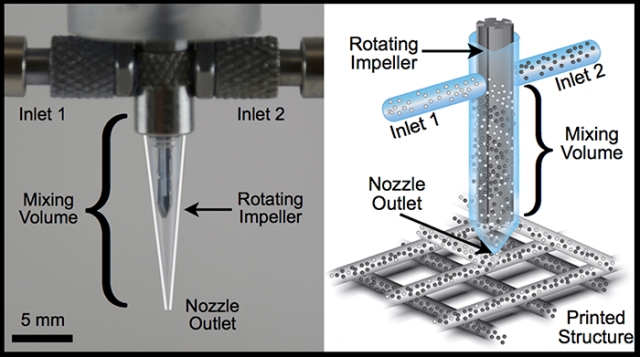 Optical image (left) and schematic illustration (right) of impeller-based mixing nozzle
Optical image (left) and schematic illustration (right) of impeller-based mixing nozzle
Researchers at Harvard University have designed and developed novel multimaterial printheads, which are capable of mixing and printing concentrated viscoelastic inks that enable simultaneous control of both geometry and composition during 3D printing.
The innovative printheads could help in the development of electronics, soft robots and wearable devices that are completely 3D printed. They utilize fast switching and active mixing nozzles for changing the material composition even while the 3D printer is in operation, and hence, enable realization of multimaterial 3D printing.
A desirable 3D printer must possess the capability to easily switch from printing a flexible material to a rigid material. In flexible electronics, the rigid material would hold the electronic components, while a flexible material would move along with the human joints when used for wearable applications. Additionally, the printer should be capable of utilizing multiple inks that have different resistivity and conductivity, and use them for accurately embedding electrical circuitry. And, it would be ideal to do all of this without the stopping the printing process.
The next advancement in 3D printing would be the integration of disparate properties and materials inside printed objects.
Jennifer A. Lewis, the Hansjörg Wyss Professor of Biologically Inspired Engineering at the Harvard John A. Paulson School of Engineering and Applied Sciences (SEAS) and a Core Faculty Member at the Wyss Institute for Biologically Inspired Engineering at Harvard, has led the research. The study paper has been published in The Proceedings of the National Academy of Sciences.
Printing of a wide range of materials requires mixing of complex fluids. Typically, two streams of fluids are made to converge in a single channel where diffusive mixing takes place. While this method is suitable for low-viscosity fluids, it is not effective with gels and other such high-viscosity fluids, particularly at short timescales and small volumes.
The novel multimaterial printhead was designed by Lewis, together with Daniele Foresti, the Society in Science Branco Weiss postdoctoral fellow; and Thomas Ober, former postdoctoral research scholar at the Wyss Institute. The new printer has a rotating impeller located inside a microscale nozzle that is capable of efficiently mixing different types of complex fluids.
Passive mixtures don’t guarantee perfectly mixed materials, especially highly viscous inks. We developed a rational framework — and verified it experimentally — for designing active microfluidic mixers that can mix a wide variety of materials.
Ober
Based on this knowledge, the research team created active mixing printheads that could be used for 3D patterning of heterogeneous materials.
The active mixing technology could be used for a wide range of applications. Silicone elastomers could be printed seamlessly into architectures that have both rigid and soft regions. These structures could possibly be used for soft robotics, wearable devices and flexible electronics applications. The team also printed two-part epoxies, and other such reactive materials that become hard very rapidly when they are combined. Furthermore, they also demonstrated that resistive and conductive inks could be mixed whenever required for embedding electrical circuitry within 3D printed objects.
The recent work by the Lewis Group is a significant advancement to the field of additive manufacturing. By allowing for the mixing of two highly viscous materials on the fly, the promise of mixed material systems with disparate mechanical and functional properties becomes much more realistic. Before, this was really only a concept. This work will be foundational for applications which required integrated electrical and structural materials.
Christopher Spadaccini, Director of the Center for Engineered Materials
Researchers at Lewis’ lab previously designed a printhead that had the ability to quickly switch from one ink to another inside a single nozzle. This prevents the formation of any structural defects that may occur when the process is started or stopped for switching materials.
This printhead design eliminates the need to align multiple nozzles as well as start and stop ink flow on demand.
James Hardin
“Together, these active mixing and switching printheads provide an important advance for multimaterial 3D printing,” said Lewis. “They allow one to programmably control both materials composition and structure at the microscale, opening new avenues for creating materials by design.”
The Department of Energy Frontier Research Center on Light-Material Interactions in Energy Conversion supported this research.
References